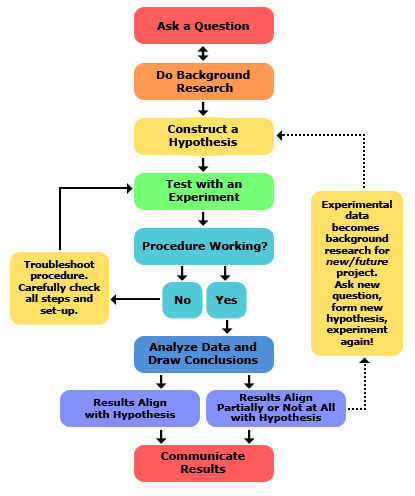Learning Objectives
- Review the applied practices of the scientific method from school experiences
- Investigate collective beliefs about science and scientists
- Explore personal values for science and the scientific method
Materials and Resources
- collaborative tool: a display/board on which you can draw and write/type
- physical tools: whiteboard or chart paper
- digital tools: Google Slides, Zoom whiteboard, Miro whiteboard
- digital devices with Internet connectivity and a video app or browser
- iPad with YouTube application or Safari browser
- information on the scientific method:

https://www.sciencebuddies.org/science-fair-projects/science-fair/steps-of-the-scientific-method
- Additional Resources:
Opening Activity: ~15 minutes
- The purpose of the opening activity is to connect with learners’ prior knowledge and experience with the scientific method.
- Ask learners what they can recall from school or other experiences about the scientific method. List the aspects on the display/board that they correctly identify. If needed, you can draw the flowchart, show videos, or provide other prompts.
- Once the flowchart is completed for the scientific method, share an example case using the scientific method.
- Example from https://courses.lumenlearning.com/boundless-psychology/chapter/the-scientific-method/
- Observation: My toaster doesn’t work.
- Question: Is something wrong with my electrical outlet?
- Hypothesis: If something is wrong with the outlet, my coffeemaker also won’t work when plugged into it.
- Experiment: I plug my coffeemaker into the outlet.
- Result: My coffeemaker works!
- Conclusion: My electrical outlet works, but my toaster still won’t toast my bread.
- Refine the hypothesis: My toaster is broken.
- Example from https://courses.lumenlearning.com/boundless-psychology/chapter/the-scientific-method/
- The intent of completing this representation of the scientific method is to pose the issue to the learners: The scientific method is meant to show the universality of science, how anyone can engage in science, but what does that mean for the scientific method since it was designed by white men to be applied to things that white people think are problems? In this project, as scientists, we will think about our values and our beliefs when we define who is a scientist is and what a scientist does.
Content and Activities: ~60 minutes
- In this activity, learners will explore their beliefs and values related to science and scientists.
- Learners start by exploring popular media, e.g., online videos, related to who is a scientist and what does a scientist do? The intent of this exploration is to have them find similarities and differences, and consider whether they agree or disagree. Have them take notes using a table:
| AGREE | DISAGREE | |
| SIMILARITIES | ||
| DIFFERENCES |
- Prior to sending learners to search, you may choose to watch an example video and discuss what aspects stand out. For example, in the video Let’s Be Scientists!, the child immediately puts on a lab coat and safety goggles. That might be laboratory science, but is that what science looks like when geologists apply science in the Grand Canyon?
- Learners with digital devices can work individually, in pairs, or in small groups. Explain that they will have 20 minutes to research videos and take notes using the table. Remind them to choose videos wisely given the short amount of time: consider length, thumbnail image, title, and description. Provide possible search terms if need, e.g., who is a scientist, what does a scientist do.
- Return to the whole group and, together, create a group version of the similarities and differences chart, negotiating areas of disagreement about where things are placed and what different learners believe.
- End with discussion. To the learners: Throughout this project, we want to explore what we believe about science and how science can and should be applied in our lives and our communities. As we think about that, we want to consider what others believe and how we feel about that. Let’s think about some examples:
- What is the act of science? Who can do it? Who should do it? How should they do it?
- Should science be more problem-driven or more inquiry-driven? Should we only engage in science if it helps to solve an immediate problem for us and our lives?
- What do you think of these belief statements?
- Scientists come in all shapes, sizes, and colors.
- Systemic factors have negatively impacted Black communities.
- Youth have an important role in the community.
Closing Activity: ~15 minutes
- Journal prompt: In your own words, describe what it means to be a “scientist.”
Continuing the Conversation: ~on their own
- Talk with family members about famous African American scientists. What made those scientists important? What problems did the scientists try to solve by applying science? What issues in your community could be explored by applying science?
Media Attributions
- Scientific Method
